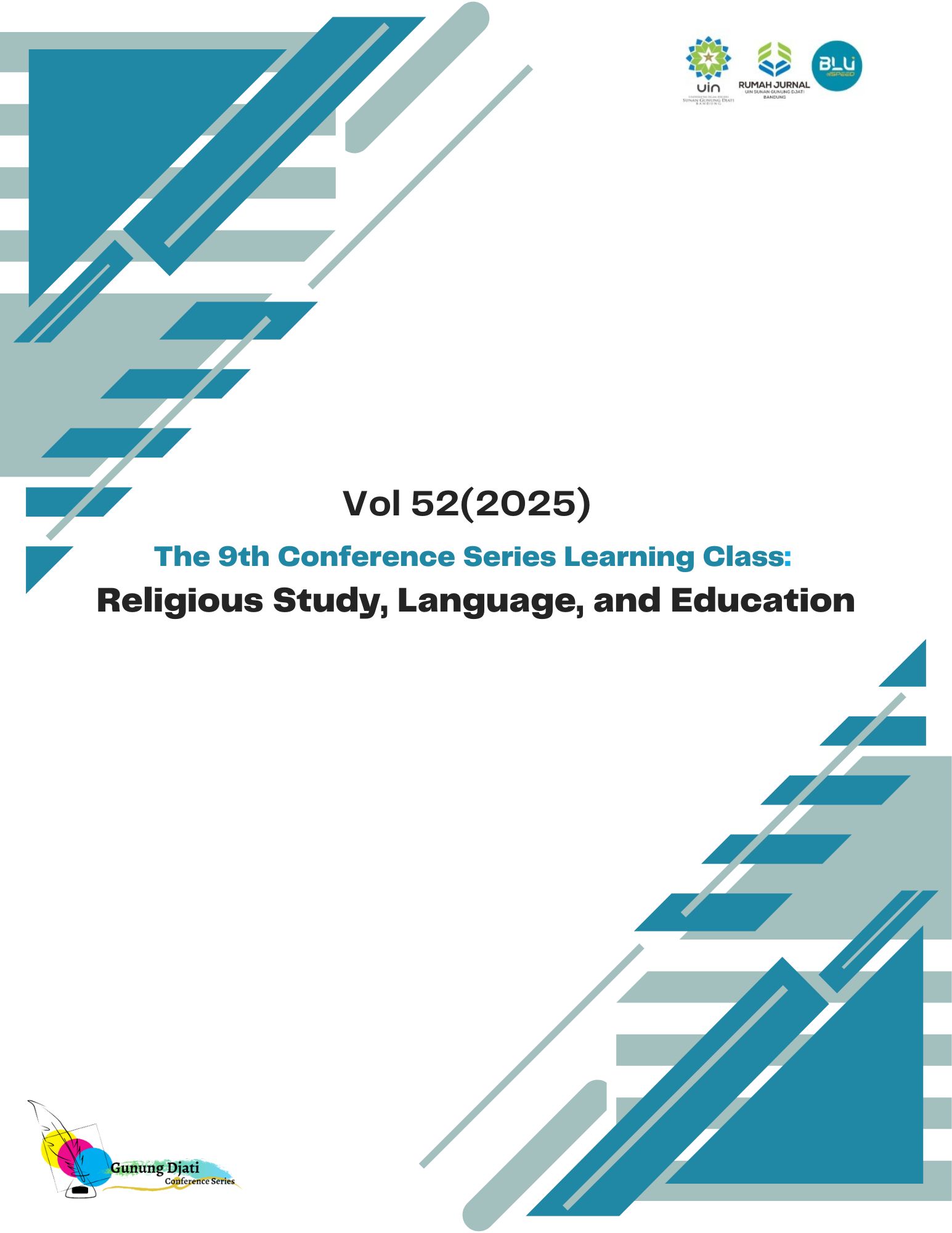An Analysis of Inflectional Morphemes and Derivational Morphemes in Selena Gomez Talkshow About Mental Health Awareness
Keywords:
Inflectional morphemes, derivational morphemes, mental health awareness, qualitative analysis, Selena GomezAbstract
This study investigates the use of inflectional and derivational morphemes in Selena Gomez’s
talkshow on mental health awareness. Using a descriptive qualitative approach, the research
analyzes transcripts from selected episodes through purposive sampling. Data collection involved
transcript analysis, morpheme identification, and classification based on meaning. The findings
reveal 207 total morphemes, comprising 172 inflectional morphemes (83,1%) and 35 derivational
morphemes (16,9%). Eight types of inflectional morphemes were identified, primarily used for
grammatical functions. Derivational morphemes included noun-forming, adjective-forming, adverbforming, and verb-forming suffixes, along with verb-forming prefixes, contributing to vocabulary
enrichment and meaning variation in mental health discussions.
Downloads
References
Arbi, A. P., Sulistyaningsih, S., Syakur, A., & Lestariningsih, L. (2022). Derivational and Inflectional Morphemes on the Thesis Abstracts. Jurnal Basicedu, 6(3), 3895–3907.
Aronoff, M., & Fudeman, K. (2022). What is morphology? John Wiley & Sons. https://books.google.com/books?hl=id&lr=&id=v-uKEAAAQBAJ&oi=fnd&pg=PR8&dq=According+to+linguistic+theory,+morphemes+are+the+most+basic+components+of+meaning,+and+comprehending+them+is+necessary+to+become+proficient+in+any+language.+&ots=1q-wfe9Yak&sig=uw8rQx4FwjTz_Z_AKbYBtQ79rfQ
Aslamiah, S. (2020). The Use Of Prefixes And Suffixes For Increasing Vocabulary Students. FIKRUNA: Jurnal Kependidikan Dan Kemasyarakatan, 2(1), 41–55.
Aziz, M. R., Libra, I., Putri, D., Purwanto, T., & Chusna, N. (2019). DERIVATIONAL AND INFLECTIONAL MORPHEME IN ENGLISH LANGUAGE. JOSAR (Journal of Students Academic Research), 2(2), 17–27.
Dawson, C. (2011). Shared alternatives to subject-verb agreement: The 3rd singular verb and its uses in English and Brittonic [PhD Thesis, Dissertation, Albert-Ludwigs-Universität Freiburg, 2011]. https://www.freidok.uni-freiburg.de/dnb/download/8614
Elo, S., & Kyngäs, H. (2008). The qualitative content analysis process. Journal of Advanced Nursing, 62(1), 107–115. https://doi.org/10.1111/j.1365-2648.2007.04569.x
Faloju, J. (2022). A Comparative Study of Adjectives in English, Russian, and Yoruba. Ihafa: A Journal of African Studies, 13(1), 157–181.
Fiedler, K. (2008). Language: A Toolbox for Sharing and Influencing Social Reality. Perspectives on Psychological Science, 3(1), 38–47. https://doi.org/10.1111/j.1745-6916.2008.00060.x
Fitria, T. N. (2020a). An analysis of derivational and inflectional morpheme in selected news from tempo. Co. Rainbow: Journal of Literature, Linguistics and Culture Studies, 9(2), 146–155.
Fitria, T. N. (2020b). An analysis of derivational and inflectional morpheme in selected news from tempo. Co. Rainbow: Journal of Literature, Linguistics and Culture Studies, 9(2), 146–155.
Gea, N. (2024). Word-Formation of Superlative Degree of Adjectives in Nias Language in Soera Ni’amoni’õ. METHOLANGUE: Language Teaching and Literature, Linguistics and Literature, 9(1), 1–14.
Halawa, A. (2017). An analysis of derivational and inflectional English morphemes. Jurnal Ilmiah Langue and Parole, 1(1), 132–144.
Hamidah, A. U. (2022). An Analysis of Students’ Error in Using Plural Forms of Nouns [B.S. thesis, Jakarta: FITK UIN Syarif Hidayatullah Jakarta]. https://repository.uinjkt.ac.id/dspace/handle/123456789/60838
Hasibuan, N. P. (2021). An analysis of prefixes and suffixes in Jakarta Post online articles 2020 [PhD Thesis, IAIN Padangsidimpuan]. http://etd.uinsyahada.ac.id/7316/
Joshi, M. (2016). Regular and Irregular Verbs: English Verb Forms (Vol. 35). Manik Joshi. https://books.google.com/books?hl=id&lr=&id=w3ZBDQAAQBAJ&oi=fnd&pg=PT4&dq=Regular+verbs+form+their+past+tense+by+adding+%E2%80%98-ed%E2%80%99+or+%E2%80%98-d%E2%80%99+in+base+or+simple+present+form+(Joshi,+2016&ots=7MLOvlUTXD&sig=gf7Z64y_JbYEi9Cqr79UqbkeNsg
Kumari, R. (n.d.). Shaping Societal Realities: The Dynamic relationship Between Language And Social Norms. Retrieved December 17, 2024, from https://www.researchgate.net/profile/Rabita_Kumari/publication/385110361_Shaping_Societal_Realities_The_Dynamicrelationship_Between_Language_And_Social_Norms/Links/67173d1a09ba2d0c76175718/Shaping-Societal-Realities-The Dynamicrelationship-Between-Language-And-Social-Norms.pdf
Martini, I. D. A. K. (2016). Derivational of bound morpheme. International Research Journal of Management, IT and Social Sciences, 3(1), 15–22.
Maulidina, S., Indriyani, F., & Mardewi, T. (2019). Derivational and inflectional morphemes in the Jakarta Post. Journal of English Teaching and Research, 4(2), 104–122.
Nandito, I. K. (2016a). Derivational and inflectional morphemes. International Research Journal of Engineering, IT and Scientific Research, 2(1), 22–29.
Nandito, I. K. (2016b). Derivational and inflectional morphemes. International Research Journal of Engineering, IT and Scientific Research, 2(1), 22–29.
Poikela, V. (2024). Linguistic variation and change in the past participle in British English: A Corpus-based Analysis [Master’s Thesis, Itä-Suomen yliopisto]. https://erepo.uef.fi/bitstream/handle/123456789/33290/urn_nbn_fi_uef-20241700.pdf?sequence=1
Seixas, B. V., Smith, N., & Mitton, C. (2018). The qualitative descriptive approach in international comparative studies: Using online qualitative surveys. International Journal of Health Policy and Management, 7(9), 778.
Thomas, F. B. (2022). The role of purposive sampling technique as a tool for informal choices in a social Sciences in research methods. Just Agriculture, 2(5), 1–8.
Vede, E. V., & Leleka, E. V. (2019). Peculiarities of usage of the possessive case of nouns in articles and poetry. Язык в Сфере Профессиональной Коммуникации.—Екатеринбург, 2019, 239–241.
Walter, M. (2018). Language effects on mental health stigma. https://wuir.washburn.edu/handle/10425/1775
Yusuf, A. (2017). Different Criteria between Derivational and Inflectional Morphemes In English. Education and Human Development Journal, 2(2). http://journal2.unusa.ac.id/index.php/EHDJ/article/view/1377
Zaniar, S., Authar, N., Aquariza, N. R., Rihlah, J., & Sucita, A. A. P. (2024). Comprehensive Analysis of Derivational and Inflectional Morphemes for English Language Acquisition. Jurnal Pendidikan Indonesia, 5(8). https://search.ebscohost.com/login.aspx?direct=true&profile=ehost&scope=site&authtype=crawler&jrnl=27457141&AN=179992600&h=2b3ScfM%2B%2FIIScMkQ4bazYyvmK6D55STv%2Fnb5YrPOJauY4QBxSAS1Jih3B2fj90o6YY8iAqdqeFcR%2FXmsyNKsTw%3D%3D&crl=c
Downloads
Published
Issue
Section
Citation Check
License
Copyright (c) 2025 Finka Mareta

This work is licensed under a Creative Commons Attribution 4.0 International License.



